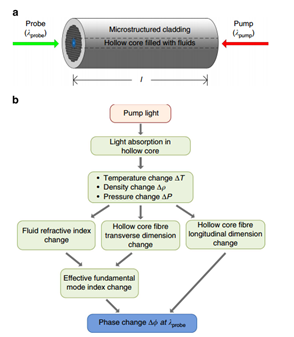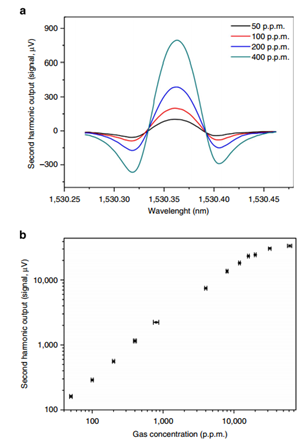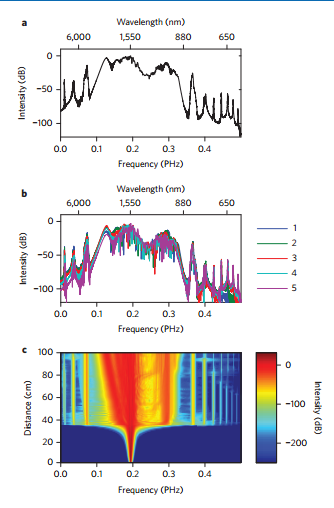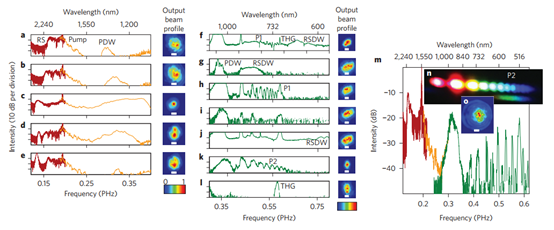一、本期重点:
1.大动态范围的超灵敏全纤维光热光谱(Ultra-sensitive all-fibre photothermal spectroscopy with large dynamic range)【NATURE COMMUNICATIONS】
DOI: 10.1038/ncomms7767
Published:2015.4.13
内容介绍:
光热干涉仪是一种超灵敏的光谱方法,用于气相和液相材料的痕量化学检测。 以前的光学干涉仪系统使用的是空间光学,具有以下的局限性:光与物质转换效率低,尺寸大,光学校准困难,很难集成到集成光路中。这里我们利用有空气填充的空心洞光子带隙光纤中光热导致的相位变化,证明一种全光纤的乙炔气体传感器,其等效噪声浓度为2p.p.b,(吸收系数2.3*10-9cm),并且其动态范围史无前例,将近六个数量级。使用低成本近红外半导体激光器和基于光纤的技术实现的光热干涉仪,能够产生一大类具有以下特点的光学传感器:尺寸紧凑、超灵敏和超强选择性、恶劣环境的使用、远程多点和分布式传感的能力。

图一 空气填充的空心洞光子带隙光纤中光热诱导的相位调制

图二 使用10m长空气填充的空心洞光子带隙光纤的气体检测实验装置

图三 二次谐波信号与气体浓度的关系
2.多模光纤中可控的时空非线性效应(Controllable spatiotemporal nonlinear effects in multimode fibres)【NATURE PHOTONICS】
DOI: 10.1038/NPHOTON.2015.61
Published:2015.4.13
内容介绍:
多模光纤和下一代通讯系统以及高能量光纤激光器密切相关。然而,相对而言探索多模光纤中非线性的脉冲传播的工作还比较少。这里,我们考虑一种高能非线性超短脉冲在渐变折射率多模光纤的反常色散区域传播。 低的模式色散和光纤许多的空间模式之间很强的非线性耦合导致了很多有趣的现象。我们在体介质的非线性光学中观察到了时空效应的存储---自聚焦和多种激光成丝—是通常能量的一小部分。通过调整空间初始条件,我们按照需求产生了兆瓦特的超短脉冲,并且在1550和2200nm之间可调谐;弥散波超过一个倍频程;强烈的可见光波段的光梳;和多频程范围的超连续谱。我们的结果表明多模光纤在观察时空的动力学和现象中呈现了唯一的可能性。他们同时实现了一种新型的可调谐、宽频的光纤光源,这些光源在许多场合可以被用到。

图一 高能非线性超短脉冲在渐变折射率多模光纤传播的光谱特征仿真图

图二 在频域优化效应的实验结果
二、简讯:
DOI: 10.1038/srep09601
Published:2015.4.27
Abstract:
Integrated photonics promises solutions to questions of stability, complexity, and size in quantum optics. Advances in tunable and non-planar integrated platforms, such as laser-inscribed photonics, continue to bring the realisation of quantum advantages in computation and metrology ever closer, perhaps most easily seen in multi-path interferometry. Here we demonstrate control of two-photon interference in a chip-scale 3D multi-path interferometer, showing a reduced periodicity and enhanced visibility compared to single photon measurements. Observed non-classical visibilities are widely tunable, and explained well by theoretical predictions based on classical measurements. With these predictions we extract Fisher information approaching a theoretical maximum. Our results open a path to quantum enhanced phase measurements.
Published:2015.3.5
Abstract:
Rapid progress in integrated photonics has fostered numerous chip-scale sensing, computing and signal processing technologies. However, many crucial filtering and signal delay operations are difficult to perform with all-optical devices. Unlike photons propagating at luminal speeds, GHz-acoustic phonons moving at slower velocities allow information to be stored, filtered and delayed over comparatively smaller length-scales with remarkable fidelity. Hence, controllable and efficient coupling between coherent photons and phonons enables new signal processing technologies that greatly enhance the performance and potential impact of integrated photonics. Here we demonstrate a mechanism for coherent information processing based on travelling-wave photon–phonon transduction, which achieves a phonon emit-and-receive process between distinct nanophotonic waveguides. Using this device, physics—which supports GHz frequencies—we create wavelength-insensitive radiofrequency photonic filters with frequency selectivity, narrow-linewidth and high power-handling in silicon. More generally, this emit-receive concept is the impetus for enabling new signal processing schemes.
DOI: 10.1038/nphoton.2015.65
Published:2015.4.40
Abstract:
Multi-cavity photonic systems, also known as photonic molecules, exhibit multi-well potentials that may prove useful for advanced quantum and nonlinear optics. A key phenomenon arising in double-well potentials is the spontaneous breaking of inversion symmetry, with a transition to two localized states in the wells, which are mirror images of each other. Although a few theoretical studies have addressed mirror-symmetry breaking in micro- and nanophotonic systems, no experimental evidence has been reported to date. Here, we demonstrate spontaneous mirror-symmetry breaking through a pitchfork bifurcation in a photonic molecule composed of two coupled photonic-crystal nanolasers. The coexistence of localized states is shown by switching them with short pulses. This offers exciting prospects for the realization of ultra-compact, integrated, scalable optical flip-flops. Analysis suggests that such symmetry breaking should be possible with a small number of intracavity photons and is thus suitable for quantum correlation devices.
DOI: 10.1038/518458b
Published:2015.2.25
Abstract:
Researchers have developed a microscopic lens with a focal length that can be controlled in less than a millisecond.
Controlling the focus of an optical lens is useful for microscopy and photography, but existing reconfigurable lenses are often bulky or slow to adjust. Romain Quidant and his colleagues at the Institute of Photonic Sciences in Barcelona, Spain, created a controllable lens by placing a disc of gold nanorods inside a thin chamber of water and putting it on top of a conventional lens.
They used a laser to excite the electrons in the nanorods, heating the water and changing its refractive index to create a lens-like effect. The team was able to vary the focal distance of the lens by tens of micrometres with sub-nanometre accuracy, and in only 200 microseconds.
供稿:段昌琪







